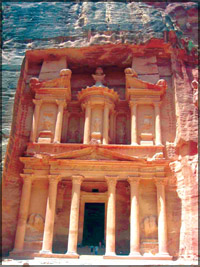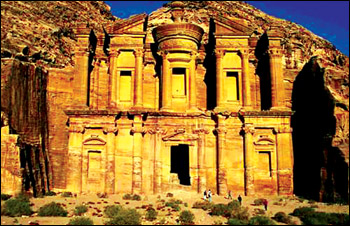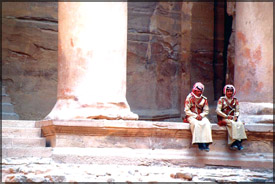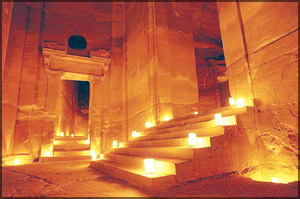Petra, the treasure of Jordan
Little Blue Birdie's diary
Dear
Diary,
 Did
you enjoy our visit to the Taj Mahal the previous week? Here we are, on
our journey through the Did
you enjoy our visit to the Taj Mahal the previous week? Here we are, on
our journey through the modern wonders of the world and this time, our destination is Petra, a
city that was once called the 'Lost City'.
modern wonders of the world and this time, our destination is Petra, a
city that was once called the 'Lost City'.
When we were getting ready for our journey, we were told that the
best time to see Petra, especially since we were planning to take
photographs, was either early to mid-morning or late afternoon, when the
angled sun highlights and enhances the amazing natural colours of the
rocks. Therefore, we scheduled our visit for the late afternoon. We wore
comfortable walking shoes and hats to protect ourselves from the sun,
and took plenty of drinking water.
Though Petra was an important city in ancient times, after the 14th
century AD, it was completely lost to the western world. It was
rediscovered in 1812 by the Swiss traveller, Johann Ludwig Burkhart, who
tricked his way into the tightly protected site by pretending to be an
Arab from India wishing to make a sacrifice at the tomb of Prophet
Aaron.
The giant red mountains and enormous tomb, which is the remains of a
dead battle, have nothing in common with modern civilization.
They also ask for nothing, except to be appreciated at their true
value - as one of the greatest wonders ever wrought by Nature and Man.
Petra was earlier often described as the eighth wonder of the ancient
world; it is without doubt Jordan's most valuable treasure and greatest
tourist attraction. The entrance to the city is through the Siq, a
narrow canyon, over one kilometre in length, which is lined on either
side by elevated, 80-metre high cliffs. Just walking through the Siq is
an experience in itself.
The colours and formations of the rocks are dazzling. As you reach
the end of the Siq, you will catch your first glimpse of Al-Khazneh (the Treasury).
first glimpse of Al-Khazneh (the Treasury).
This is an overwhelming experience. The massive structure, 30m wide
and 43m high, carved out of the pure, dark pink rock-face dwarfs
everything around it. The Treasury is just the first of the many wonders
that make up Petra. Four or five days are required to explore everything
here.
As we entered the Petra Valley, we were overwhelmed by the natural
beauty of the place and its outstanding architectural features. There
are hundreds of detailed rock-cut tombs with complex carvings. Unlike
the houses, which were destroyed mostly by earthquakes, the tombs were
carved to last for years; and 500 of them have survived, empty, but
fascinating.
There is a Roman-style theatre, which could seat 3,000 people. There
are temples, sacrificial altars and colonnaded (architectural feature
where a row of columns usually supports a roof or arches) streets, and
high above, overlooking the valley is the impressive Ad-Deir Monastery;
a flight of 800-rock cut steps taking the visitor there.
Within the site, there are also two excellent museums; the Petra
Archaeological Museum and the Petra Nabataean Museum, both of which
represent finds from excavations in the Petra region and an insight into Petra's colourful past.
Petra's colourful past.
A 13th century shrine, built by the Mameluk Sultan Al Nasir Mohammad
to commemorate the death of Aaron, the brother of Moses, can be seen on
top of Mount Aaron in the Sharah range.
Visitors are not permitted to take their vehicles to the site.
However, for anyone unable to walk upto the site, a horse or a
horse-drawn carriage can be hired for the one kilometre ride through the
Siq.
The Nabataean Arabs, a nomadic tribe who settled in the area and laid
the foundations for a commercial empire that extended into Syria, first
established Petra sometime around the 6th century BC.
Despite successive attempts by the Seleucid king Antigonus, the Roman
Emperor Pompey and Herod the Great to bring Petra under the control of
their respective empires, Petra remained largely in Nabataean hands
until around 100AD, when the Romans took over. It was still inhabited
during the Byzantine period, when the former Roman Empire moved its
focus east to Constantinople, but declined in importance thereafter.
The Crusaders constructed a fort there in the 12th century, but soon
withdrew, leaving Petra to the local people until the early 19th century, when the Swiss explorer Burckhardt
rediscovered it in 1812. If any of the readers of this journal get the
opportunity to visit Jordan one day, remember, Petra should be one of
the 'must visit' places on your list.
people until the early 19th century, when the Swiss explorer Burckhardt
rediscovered it in 1812. If any of the readers of this journal get the
opportunity to visit Jordan one day, remember, Petra should be one of
the 'must visit' places on your list.
Bye!
Comments: [email protected]
|
